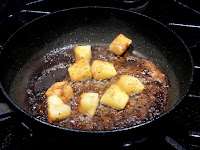Mahi Mahi On The Menu
We’re talking about one of my favorite little fishies right now. Mahi mahi, also known as dolphinfish, is a fairly firm and sweet tasting fish. It’s quite versatile and lends itself to any number of cooking techniques. Today, I’m going to season it, pan-sear it, and serve it with a fruit salsa my favorite way - in its own edible container – a fried tortilla shell.
Here’s the process:
I fried the tortillas first. They can sit in a warm oven while you prepare the salsa and fish.
I’m frying one tortilla at a time because I need to shape each one into a taco. I use mostly peanut oil for frying, but you could use vegetable or corn oils. Heat oil to about 400°. Place tortilla in pan and lightly golden the first side. Turn tortilla over and use tongs to bend the tortilla so it’s shaped like a taco. Fry the bottom part until golden brown, then turn over and get the other side of the taco. Drain on paper towels. Since these will be sitting for a while, I take the tacos and place in a warm toaster oven. Hang them upside down using the rack to keep the taco shape.
I started on the fruit salsa next. It’s going to be cooked a bit and stay warm while waiting for the mahi mahi, which doesn’t take long at all to sear. For the salsa, I’m simply giving a guideline for ingredient measurements. Taste test and adjust to your palate.
Melt butter over medium heat. Toss pineapple chunks with brown sugar until nicely coated and add to sizzling butter. Cook until pineapple is brownish and caramelly from the brown sugar. About 2 minutes. Add in rice vinegar, strawberries, orange zest and juice, jalapeño, and onion. Lightly combine and remove from heat. Stir in parsley/cilantro before serving.
Fruit ready to go.
Give the pineapple some caramelly attention.Add in rest of ingredients.
Mahi Mahi
To prepare the mahi fillets for cooking, I remove the bloodline first. That’s the dark red line that runs down the middle of the fillet along the spine. Using a sharp knife, cut it out. While it’s OK to eat, it tends to have a stronger, fishier taste, which I don’t like.
That dark line going down center is the blood line.
Me no likey.
Remove the blood line.
Next, I season my fillets. Onto a plate, evenly sprinkle about a teaspoon or two each of freshly cracked black pepper, onion powder, paprika, thyme, oregano, and red chile pepper flakes, and a few pinches of kosher salt. Place each fillet in the mixture, pressing into the seasonings, and coating both sides.
Let sit a minute or two before slicing.
To cook the fillets, I use an iron skillet. Coat it with a film of peanut oil and heat to about 400°. Throw in a tablespoon of butter, let it sizzle, spit, and melt, then place each fillet in the pan. Depending on the thickness of your fillets (Mine were about ¾ inch thick.), sear about 2 ½ minutes on the first side (Resist the temptation to move your fish around in the pan.) and about 1 ½ minutes on the flip side. Remove from pan onto plate to rest a minute. Slice into strips.
For serving:
Fill tacos with a bed of salsa and lay mahi strips on stop.
Or you can go with a more traditional serving and nestle the fish strips on a bed of your favorite coleslaw and top with a tartar sauce. Those little green balls in the tartar sauce are raw cilantro seeds, or coriander. They give a nice citrusy tang and fresh pop of cilantro flavor to whatever you add them to. And you can only find raw coriander seeds on cilantro plants in your garden.
For the Tartar Sauce:
The next time you make coleslaw, trying adding a few ingredients to up your game a bit. A splash of buttermilk in the dressing mix would be a welcome addition, as would adding a chopped apple and a handful of craisins to the cabbage mix. Remember: always taste test.
Enjoy.











































.jpg)
























